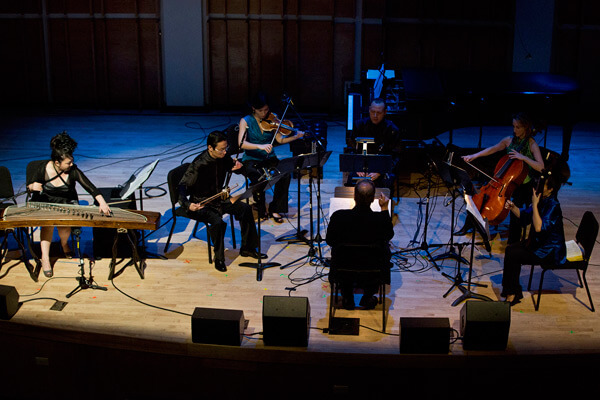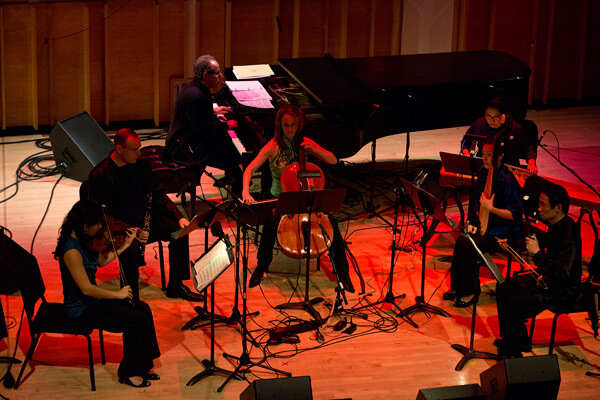

Photo by David Andrako
The concert had a higher attendance than most of the other Ecstatic concerts I’d been to, which is always a pleasure (is there anything more depressing than seeing great music while sitting in a half-capacity theater?). A small rotating ensemble of nine musicians, playing a mix of Western and Chinese instruments, helped to give the concert a unified, familial feeling. Two of the composers (Derek Bermel and Du Yun) doubled as instrumentalists as well. The show opened with a performance of Bright Sheng’s “Four Movements for Piano Trio”, written in 1988. Sheng’s piece stood as a marker for the previous generation of Chinese composers, as everything else on the program was a world premiere of a work written in 2012. Sheng, a MacArthur fellow born in Shanghai but who has lived stateside since 1982, is a master of blending seemingly disparate elements into a flowing, logical whole. His work in general, and this piece specifically, delights in the sweet pentatonics of Chinese folk music while taking advantage of their harmonic malleability. There are moments of traditional harmony, and moments of avant-garde discomfort and chaos, but his unique sense of progression is always the driving force. The trio (pianist Michael Boriskin, cellist Wilhelmina Smith and violinist Harumi Rhodes) was especially deft in their handling of the piece’s sudden textural shifts.

Photo by David Andrako
Next came the premieres of new works. First was Leung Kei-Chuek’s “Contradicting Unison” for a mixed ensemble of Western and Chinese instruments, as well as electronics and with video by Thomas Yip. Reminiscent of Messiaen, with minimalist traces, both music and video dealt with the balance of order and chaos. A section featuring a call-and-response between electronics and strings was particularly striking, the electronics calling with treated sound collages and the strings responding with serpentine melodies. Then came clarinetist Derek Bermel’s “Dragon Blue”, a study in the commonalities between American and Chinese folk music. Recalling Gershwin and Ellington from the Western side, but with an erhu (a single-string spike fiddle, played by Wang Guowei), pipa (a plucked, multi-stringed guiltar-like instrument one holds vertically, played by Sun Li) and a zheng (a gigantic plucked instrument placed on a stand, played by Ann Yao) spouting simultaneous Chinese folk melodies. One would imagine a clash here, but the Chinese elements blended with (and at times were indistinguishable from) the bluesy swing, weaving a brilliantly warm sonic tapestry.
Photo by David Andrako
Du Yun’s “The Hidden Face” followed the short intermission. Written for a larger ensemble, and featuring Yun herself on zheng, the piece was a post-Cage storm of jagged atonality, a menacing, brutal whirl of crashes, sputters and clangs. Yun smacked the strings of her zheng with a metal rod while the violin, cello and clarinet screeched in banshee harmonics, the piano thrummed darkly as its’ strings were plucked, and the pipa, erhu and zheng spat dissonant clusters of abyssal blackness, not something often heard from these instruments.
Photo by David Andrako
Closing the program was Samson Young’s “The Third Pixel”, a work in three short movements for clarinet, violin, cello, piano, pipa and electronics, featuring accompanying video by Young and Adrian Yeung. Part one, “Space Invader”, throbbed with an electronic pulse covered in gliding, ambient string lines. The piece felt electronic in general approach, not just in it’s beats but in it’s minimalistic rhythms and dreamy chords, a vibe bolstered by the video of game sprites from Space Invaders undergoing various psychedelic transformations. “That Summer, Those Silent Apple Trees” contrasted starkly, with a poem’s soft recitation over plaintive piano chords and ghostly string harmonics. The video of fractalized lines forming a gray, geometric forest soaked the room in supple melancholy. The melodies unfolded and slowly drifted away, breaking into progressively smaller fragments and dwindling into nothingness. “Signal to Noise” shattered the tranquility with a thumping industrial beat, and a doomy ostinato broken into interlocking halves amongst the piano and electronics. The atmospheric cloud of sound, as much Debussy as it was Venetian Snares, felt like a musical approximation of static: at first, it seems chaotic noise, but the longer you listen, the more your mind begins to pick out fragments and melodies. How much signal is there? How much is just our brains creating something from nothingness? Young’s suite-like piece was by far the most stimulating of the evening, intellectually and emotionally.
Was the big question answered? Did we get a “what next?”. Yes and no. That question serves to inspire rhetorically, but cannot be answered definitively. Every musician answers it in their own way with each new piece they create. The four young composers who premiered works at Merkin had some commonalities, but in each piece one could see an utterly different and individualistic take on what new music can be made with these preexisting materials. I look forward to any new answers they’ll have in the future.
—
Evan Burke is a bassist and composer living in Brooklyn.
